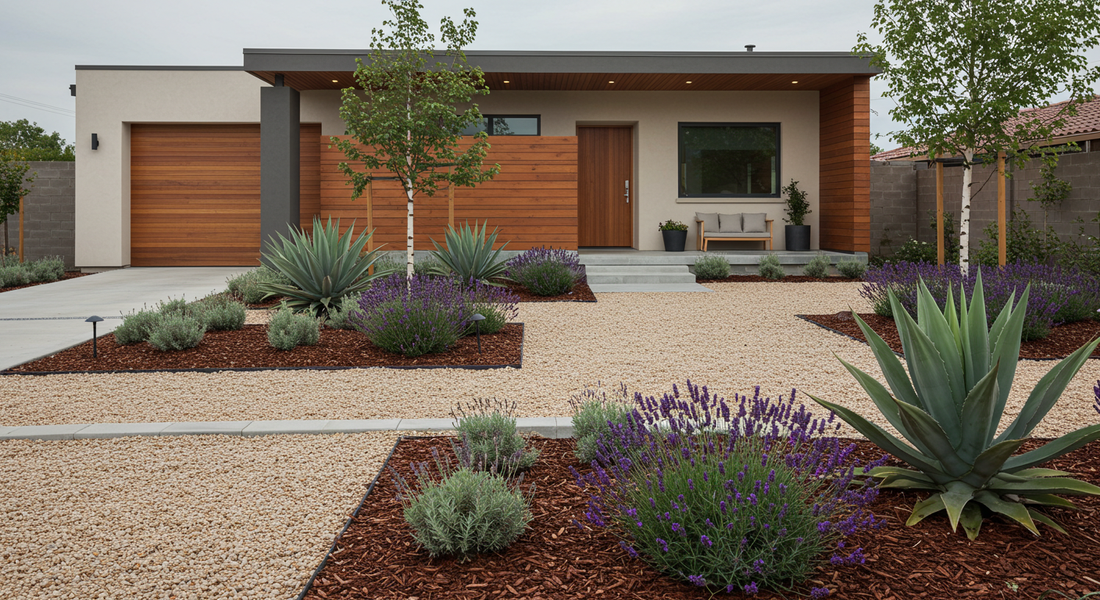
Drought-Tolerant Landscaping: 10 'Xeriscaping' Ideas to Save Water and Effort
Share

A lush, green yard is a beautiful thing, but the amount of water, time, and money required to maintain a traditional lawn is becoming increasingly unsustainable, especially in drier climates. This is where xeriscaping comes in. What is xeriscaping? It's a smart and stylish approach to landscaping that focuses on designing a garden that requires little to no supplemental irrigation.
The benefits are immense: you'll save money on your water bill, spend less time on maintenance, and create a beautiful, environmentally friendly landscape. These xeriscaping ideas are all about working with your climate, not against it.
Principle 1: Smart Plant Selection
The heart of any low water landscaping is choosing the right plants.
-
Choose Drought-Tolerant Plants: There is a vast and beautiful world of drought tolerant plants that thrive in dry conditions. Look for plants with features like silvery leaves (which reflect sunlight) or waxy/hairy foliage (which helps retain moisture).
-
Perennials: Lavender, Russian Sage, Yarrow, and Coneflower.
-
Shrubs: Rosemary and Sage.
-
Grasses: Blue Fescue and Little Bluestem.
-
Succulents: Agave and Sedum.
-
-
Group Plants by Water Needs: This is a crucial step. Group plants with similar water requirements together in "hydrozones." This allows you to water a zone of thirsty plants without overwatering the drought-tolerant ones right next to them.
Principle 2: Efficient Irrigation
When you do need to water, do it as efficiently as possible to save water in garden areas.
-
Use Drip Irrigation: Traditional sprinklers can lose up to 50% of their water to evaporation and wind. A drip irrigation system or soaker hoses deliver water directly to the base of the plants, right where it's needed, with minimal waste.
-
Water Deeply and Infrequently: This is a key principle for encouraging drought resistance. Watering deeply encourages plant roots to grow further down into the soil where it stays cooler and moister. A deep watering once a week is far more effective than a light sprinkle every day.
Principle 3: Reduce Your Lawn Size
The single thirstiest part of most landscapes is the traditional grass lawn. Reducing its size is the fastest way to slash your water usage.
-
Lawn Alternatives: Consider replacing sections of your lawn with beautiful, low-water alternatives. A bed of ornamental grasses, a patio area made with gravel or pavers, or a groundcover of creeping thyme or clover are all fantastic options that add visual interest while cutting down on your water needs.
Principle 4: Use Mulch
Mulch is a xeriscaper's secret weapon.
-
How Mulch Works: A 2-3 inch layer of mulch spread over your garden beds acts like a blanket for your soil. It shades the soil, keeping it cool, dramatically reduces water evaporation, and suppresses weed growth.
-
Best Mulch Types:
-
Organic Mulch: Wood chips, shredded bark, or pine straw are excellent choices. They retain moisture and enrich the soil as they break down over time.
-
Inorganic Mulch: Gravel, pebbles, or crushed stone are great for a modern, desert-inspired look and are extremely low-maintenance. They are perfect for use around succulents and other plants that prefer dry, well-draining conditions.
-
Conclusion: A Sustainable and Stylish Landscape
Xeriscaping is the future of smart gardening. It's a sustainable and stylish approach that proves you don't have to sacrifice beauty to save water.
